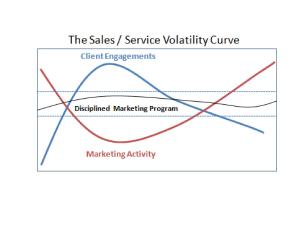 There are two reasons why marketing fails most often at small- and medium-sized B2B firms. Either or both of these failings may apply to your situation:
There are two reasons why marketing fails most often at small- and medium-sized B2B firms. Either or both of these failings may apply to your situation:
You view marketing as business triage. Your company uses a collection of tactics (often labeled as a “marketing campaign”) only in response to a problem; typically involving the loss of a key client, or decline in revenue. When business is good, little or no time is invested in marketing. When business (inevitably) takes a dip, only then does marketing becomes a priority.
You expect marketing to deliver immediate results. Either because your company always views marketing on a “cause & effect” tactical basis, or because marketing triage must be applied quickly to revive an ailing company, the marketing function is given insufficient time to produce tangible results. It’s no surprise that marketing professionals have the shortest tenure of any corporate function in the asset management business.
The hard truth is that very few B2B business owners either understand the marketing function, or have the discipline to design, implement, measure and adhere to a consistent marketing approach that builds brand equity and market engagement over a sustained period.
To establish the infrastructure and internal culture necessary for the marketing discipline to succeed, we offer the following simple strategy:
- Create a Written Marketing Plan. This need not be in a 3-inch binder; a two-page document is often sufficient. Include goals, strategies, responsibilities, timelines, budgets and ways to measure results. Without a Marketing Plan you’ll waste lots of time and money. And unless it’s a written document, you won’t have commitment or accountability.
- Gain Senior Level Commitment. The honcho in corner office (which might be you) must understand, endorse and support the Marketing Plan. This involves more than lip service. If your Plan isn’t properly staffed and funded at the outset, there’s no real commitment to marketing.
- Do a Few Things Very Well. Your marketing success will be based on the quality and effectiveness of a limited number of strategies / tactics. Firms sometimes go overboard, thinking there’s a correlation between the size of its marketing investment and business results. But less can often be more, in terms of marketing ROI.
- Build and Nurture your Database. Direct and easy access to your company’s clients, prospects, referral sources and opinion leaders is essential. Without an email pipeline, the marketing value of the content you create is close to zero. If your firm’s thought leadership simply sits on its website or social media, you’re missing the opportunity to build relationships with your target audiences.
- Create Meaningful Content. Self-serving, long-winded white papers and research reports have very limited appeal. Generate content that validates your company’s intellectual capital, that’s easy to read, and focuses on timely topics that people have a genuine interest in. These topics do not include how great your firm is. Allow people to draw their own conclusions.
- Drive Top-of-Mind Awareness. To be included on the short list of candidates for an assignment or sale, you need to build awareness with key decision-makers. To accomplish that goal, share your content directly with target audiences on a quarterly basis. (More frequently than that, and you may be viewed as a pest.)
Most importantly – with apologies to Glengarry Glen Ross – B2B firms must commit to:
A…..Always
B…..Be
M….Marketing
…for the discipline to be effective. Otherwise, the traditional short-term, hair-on-fire approach to business development will keep your company from ever reaching its full potential, regardless of its quality or reputation.










